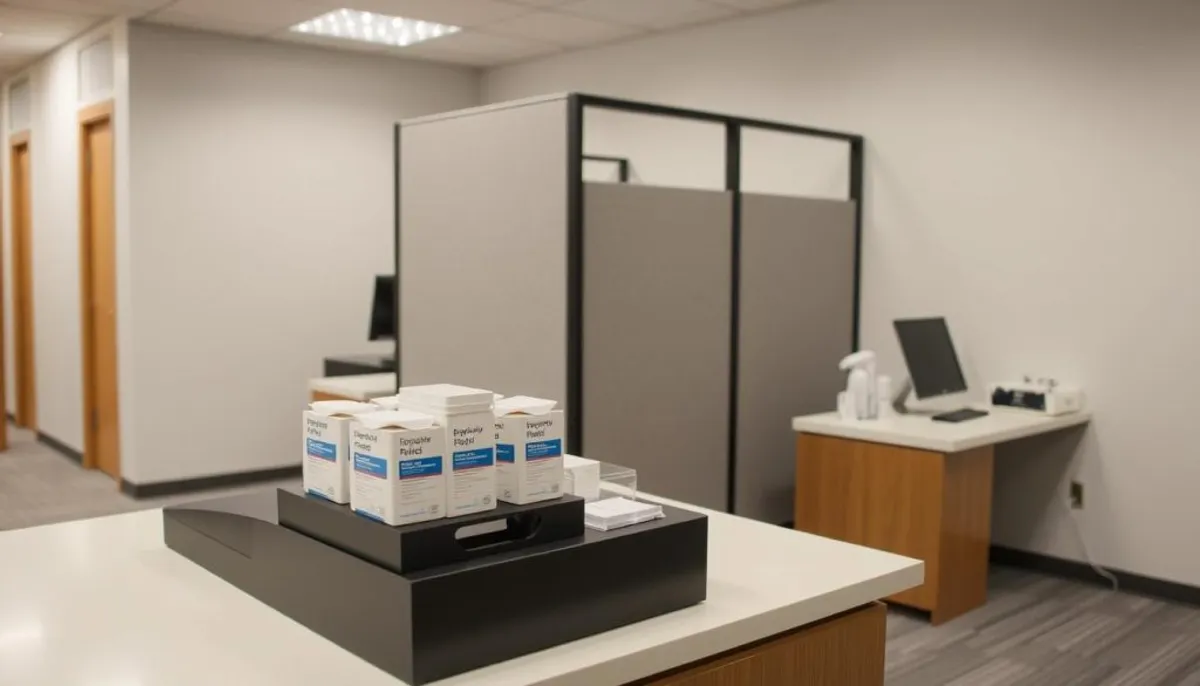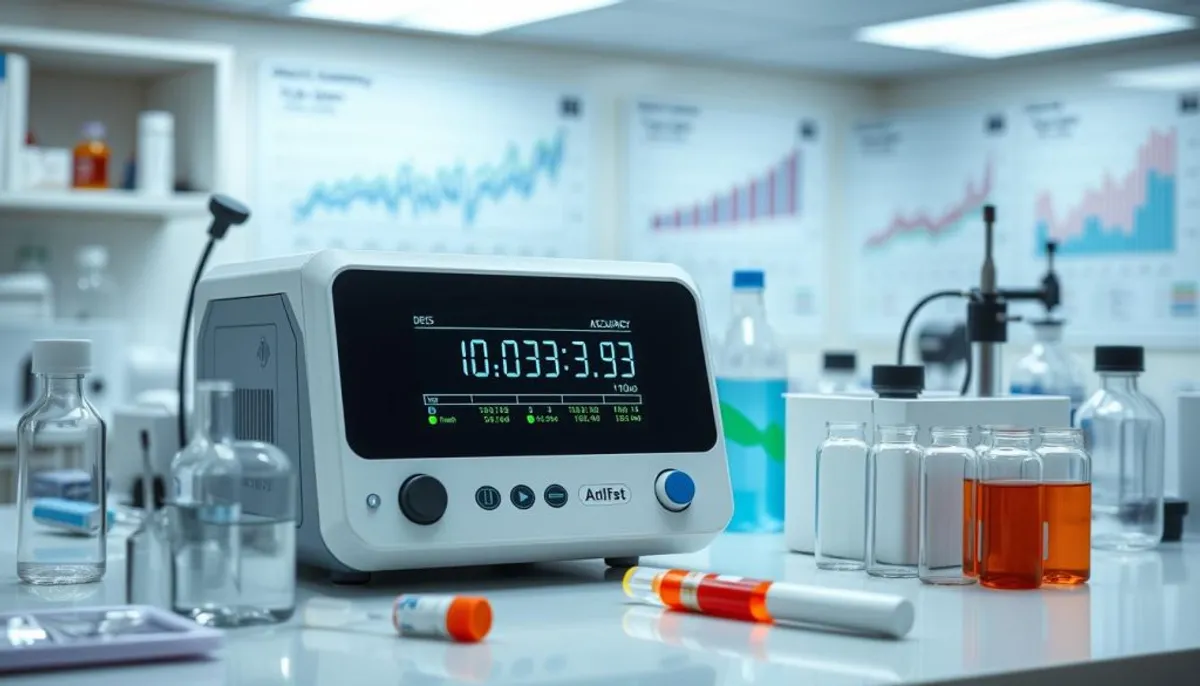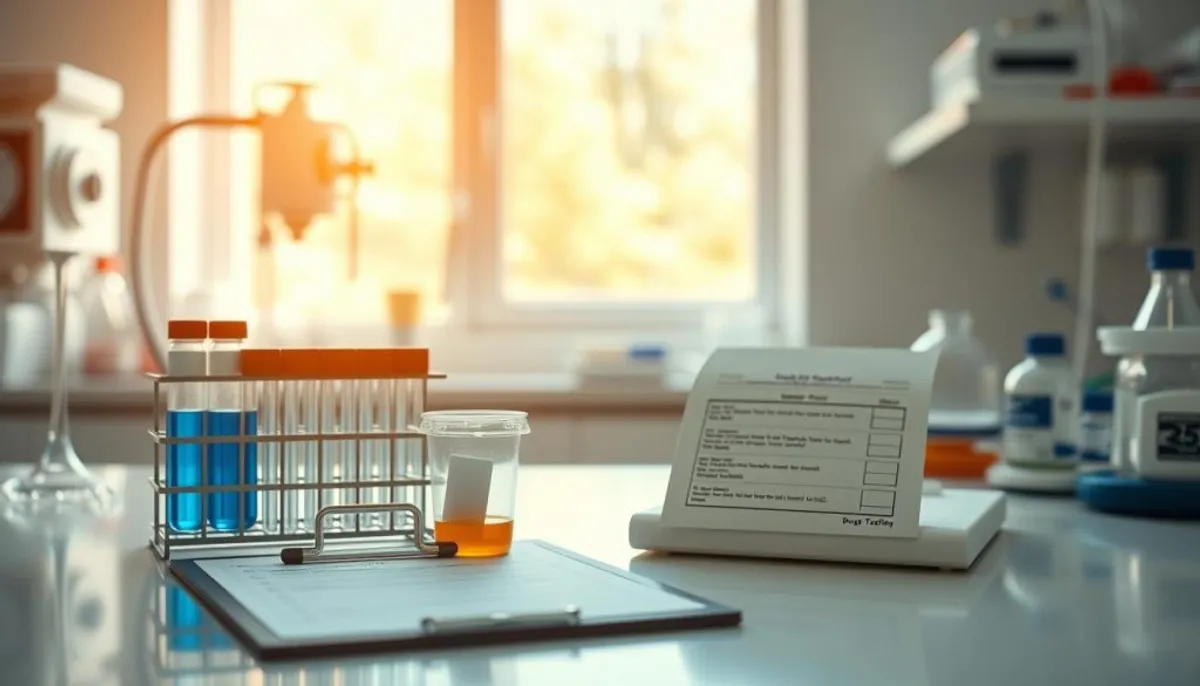Drug testing is a key part of keeping the workplace drug-free. It’s used to prevent and deter drug use. All drug-testing programs must follow local, state, and federal laws. Employers have many drug test options, from basic to comprehensive.
A common test is the 5 panel basic test. It looks for marijuana, cocaine, codeine, morphine, heroin, PCP, and amphetamines like Ritalin and Adderall. Some tests also check for MDMA (ecstasy), barbiturates, and prescription opioids like oxycodone. And, they might test for alcohol use too.

Key Takeaways
- Workplace drug testing is a common prevention and deterrent method
- Employers have various drug testing options, including basic and more comprehensive panels
- Drug testing programs must comply with applicable local, state, and federal laws
- Common drug tests screen for substances like marijuana, cocaine, opioids, and amphetamines
- Employers may also test for other drugs like MDMA, barbiturates, and prescription opioids
Employee Drug Testing: A Comprehensive Overview
Workplace substance abuse policies set clear rules for drug testing. Employers must follow local, state, and federal laws. The government has set rules for drug testing programs and how to check testing labs.
Importance of Workplace Substance Abuse Policies
These rules cover what drugs to test for, how to check if the sample is real, and how to analyze biomarkers. Employers need to know their employees’ rights during drug tests. This includes the right to test a second sample in another lab.
Legal Considerations for Drug Testing Employees
Federal rules are key to making drug testing fair and right. Employers must keep up with these rules to avoid legal issues and protect employee rights. By having strong substance abuse policies, companies can create a safe, drug-free workplace. They also respect their employees’ privacy and rights.
| Regulation | Key Provisions |
|---|---|
| Drug-Free Workplace Act | Requires federal contractors and grantees to maintain a drug-free workplace |
| Department of Transportation (DOT) Regulations | Mandates drug and alcohol testing for safety-sensitive transportation workers |
| Occupational Safety and Health Administration (OSHA) Standards | Outlines employer responsibilities for maintaining a safe work environment |
Types of Drug Tests for Employees
Keeping the workplace safe and productive is crucial for employers. They may use drug tests on urine, hair, and saliva. It’s important for employers and employees to know the different drug tests available.
Urine Drug Screening Methods
Urine tests are the most common way to check for drugs in the workplace. They can find many substances like marijuana, cocaine, opioids, and amphetamines for a long time after use. This method is easy and not too costly, which is why many companies choose it.
Hair and Saliva Drug Testing Procedures
Hair and saliva drug tests are becoming more popular. They show what drugs someone used in the past, sometimes months ago. These tests are not as common as urine tests but give a fuller picture of drug use history.
| Drug Test Type | Detection Window | Advantages | Disadvantages |
|---|---|---|---|
| Urine | Up to 30 days |
|
|
| Hair | Up to 90 days |
|
|
| Saliva | Up to 72 hours |
|
|
Employers need to weigh the good and bad of each drug test type. This helps them pick the best fit for their workplace and rules.
employee drug testing: Ensuring Accuracy and Reliability
Ensuring drug test results are accurate and reliable is key for employers and employees. This is done by using HHS-certified labs and Medical Review Officers (MROs). They are vital for checking test results and making sure tests are correct.
The Role of Medical Review Officers (MROs)
MROs are doctors with special knowledge in drug testing and substance use disorders. They follow federal drug testing regulations. They check test results, the employee’s health history, and other info. This ensures positive tests are not mistakes due to medical use or other reasons.
Split Specimen Testing and Recourse for Employees
In federal agency tests, a sample is split into two containers. The second one is kept for more tests if needed. This method lets employees ask for a second test at another HHS-certified lab. It helps employees question the first test results and protect their employee rights.
This strict process keeps drug test accuracy high. It makes sure the testing is fair and open for everyone.

Conducting Drug Tests: Best Practices
Creating a strong best practices for drug testing program is key for employers. It helps keep the workplace safe and productive. When setting up employee drug testing procedures, there are important things to think about.
First, employers need clear workplace drug testing protocols. These should cover who gets tested, when and where tests happen, and what substances are checked for. It’s also vital to make sure employee records and test results stay private.
- Clearly define the best practices for drug testing in your organization’s policies and procedures
- Determine the specific circumstances under which employee drug testing procedures will be conducted, such as pre-employment, random, and reasonable suspicion
- Identify the substances that will be included in the workplace drug testing protocols
- Designate a responsible party within the organization to handle the confidentiality of test results
By following these best practices for drug testing, employers can make a fair and effective employee drug testing procedures program. This protects the safety and health of their workers. It also meets legal and regulatory standards.
Random Drug Testing Programs
Random drug testing programs are a strong way to stop substance abuse in the workplace. They pick employees randomly for drug tests, making everyone know they could be tested anytime. This keeps workers from using drugs, making the workplace safer and more productive.
Benefits of Random Testing for Deterrence
Well-designed random drug testing programs bring many benefits to employers:
- They stop substance abuse in the workplace by making workers think they might be tested at any time.
- They make the workplace safer by cutting down the risks from workers who are impaired.
- They boost productivity and performance in a drug-free work setting.
- They help follow workplace drug testing policies and the law.
Adding random testing to a drug-free workplace plan helps create a culture of accountability. This discourages drug use and makes the workplace safer and more productive.
Pre-Employment Drug Screening
Pre-employment drug testing is now a key step for employers to find the right workers. It helps companies spot candidates who might have used drugs or misused prescription meds. This way, employers can keep their workplaces safe and drug-free. It ensures new employees are not using substances that could harm their work or be dangerous.
Pre-employment drug screening is vital in checking out job applicants. It lets employers know more about a candidate’s choices and habits. This helps them pick the best people for their teams.
When a job offer depends on passing a drug test, it shows the employer’s dedication to a safe, productive, and drug-free work environment. This not only keeps the company safe but also shows they’re serious about handling substance abuse issues at work.
- Pre-employment drug testing helps employers find candidates who might have used drugs or misused meds.
- This method keeps the workplace safe and drug-free, making sure new hires won’t use substances that could harm their work or be dangerous.
- By making drug tests a job condition, companies learn more about a candidate’s life and choices. This helps them pick the best people for their teams.

Reasonable Suspicion and Post-Incident Testing
In the workplace, employers may test for drugs under certain conditions. This includes when there are reasonable suspicions of impairment or after a workplace incident. These tests, known as reasonable suspicion testing and post-incident testing, help keep the workplace safe for everyone.
Recognizing Signs of Impairment in the Workplace
Supervisors and managers are key in spotting substance abuse at work. They should know how to spot signs of impairment. This includes changes in behavior, mood, or looks that suggest a reasonable suspicion drug test is needed. By watching for these signs, employers can keep the workplace safe and productive.
- Behavioral changes: Erratic or unpredictable behavior, poor decision-making, or difficulty concentrating.
- Mood alterations: Sudden shifts in mood, increased irritability, or emotional outbursts.
- Physical indicators: Slurred speech, unsteady gait, or changes in appearance, such as bloodshot eyes or disheveled appearance.
Post-incident testing can also help figure out if substance use caused a workplace accident or incident. By finding out what caused these events, employers can stop them from happening again. This makes the workplace safer for everyone.
Having strong reasonable suspicion testing and post-incident testing rules is key for a safe and productive workplace. By spotting the signs of impairment and acting on them, employers can protect their workers. This helps reduce the risks linked to substance abuse at work.
Employee Assistance and Substance Abuse Prevention
Smart employers know how key employee assistance and substance abuse prevention programs are. These programs help employees dealing with substance abuse. They offer counseling, treatment, and help with getting back on track.
Rehabilitation and Reintegration Strategies
Helping employees through rehab and getting them back to work is key for staying sober and doing well. Things like follow-up tests and ongoing support make the transition smoother. This helps the employee and the company.
- employee assistance programs offer private support and resources for fighting addiction
- substance abuse prevention programs teach and empower employees to choose healthily
- rehabilitation services give full treatment and counseling to help with recovery
- workplace reintegration strategies, like follow-up tests and mentorship, create a supportive place for employees to return
By putting money into these important programs, employers can make a workplace that cares about well-being. This helps lessen the effects of substance abuse. And it helps employees beat addiction and do well.
Drug-Free Workplace Initiatives: Benefits and Challenges
Creating a drug-free workplace has many benefits for employers. It makes the workplace safer, boosts productivity, cuts down on sick days and job hopping, and lowers health care costs. But, there are hurdles in setting up and running a drug testing program. These include dealing with tough laws, keeping employee info private, and handling worker worries.
For drug-free workplace initiatives to work, they need a full plan. This plan must balance the company’s needs with what’s best for employees. Employers should weigh the benefits of drug-free workplaces and the challenges of drug testing programs. This way, they can make a program that works well, follows the law, and meets their workers’ needs.
Key Benefits of Drug-Free Workplace Initiatives
- Improved workplace safety by reducing the risk of accidents and injuries caused by impaired employees
- Increased productivity and efficiency as a result of a more focused and alert workforce
- Reduced absenteeism and employee turnover, leading to cost savings and a more stable workforce
- Lower healthcare costs associated with the treatment of substance abuse and related medical issues
Challenges of Implementing Drug Testing Programs
- Navigating complex legal and regulatory requirements to ensure compliance with local, state, and federal laws
- Ensuring the privacy and confidentiality of employee information and testing results
- Addressing potential resistance or concerns from employees, who may view drug testing as an invasion of their personal rights
- Developing and maintaining a fair and consistent testing protocol that is applied equitably across the organization
To beat these hurdles, employers need a careful and strategic plan for their drug-free workplace initiatives. By balancing what the company needs with what’s good for employees, they can make a program that’s both effective and meets the unique needs of their team.
| Benefits | Challenges |
|---|---|
| Improved workplace safety | Legal and regulatory compliance |
| Increased productivity | Employee privacy and confidentiality |
| Reduced absenteeism and turnover | Employee resistance and concerns |
| Lower healthcare costs | Developing fair and consistent testing protocols |
Conclusion
Employee drug testing is key to a drug-free workplace. It helps create a safe and productive work setting. By knowing the different testing methods and legal rules, employers can make a drug testing plan that fits their company and follows the law.
Adding drug testing to a plan that includes help for employees, stopping substance abuse, and rehab support makes it even more effective. This approach helps the workforce’s overall health and safety. It also lowers the chance of accidents at work and helps the company do better and be more productive.
This summary shows how important a good and legal drug testing program is. It highlights the benefits of a full plan against substance abuse. And it shows how crucial drug testing is for keeping a workplace safe and free of drugs.
RelatedRelated articles

